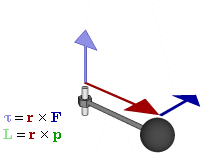The concept of torque is a foundation of human movement and is a core principle in physical therapy, personal training, and weightlifting. All movement generates torque to varying degrees and, in reality, it’s what makes the world of biomechanics tick. Torque. It’s a cool word, really. Say it. Out loud. Five times fast.
Torque is defined by kinesiologist Signe Brunnstrom as the product of a force times the perpendicular distance from its line of action to the axis of motion (or potential motion). In layman’s terms, more torque means a more effective lever. Think about opening a heavy door. If you push on the door close to the hinges, it will be more difficult to open than if you push on the side of the door furthest from the hinge (hinge = axis). A force is more effective when applied further from the axis because the length of the moment arm is greater.
You push and pull countless objects in all directions every day in the gym, and the human musculoskeletal system is nothing more than an intricate system of levers and pulleys. While we must generate torque to operate these levers and pulleys, we need to gain awareness of how to minimize torque to avoid injury. This brings us to the need to move soundly and resolve forces.
The resolution of forces occurs when we can:
- Visualize the potential effect of a force on our body.
- Determine how much torque we should generate.
- Make our muscles and joints act in proportion to this awareness.
This doesn’t happen in a clunky, calculated fashion as I just described. It is an intuitive process, and as such we do it with minimal conscious thought, moving from point A to point B as efficiently as possible. To the contrary, our “awareness” and desire to move with speed and efficiency may create dysfunctional movement patterns.
So how can you get your torque on? The answer is simpler than the explanation of torque may lead you to believe: use your muscles. Often in the gym, I see people move into a position without regard for the joint position or joint support. They place ligaments and fascia in charge of holding a joint together (wrong), rather than engaging some of the 642 muscles they have at their disposal (right). Muscles need to do the work of supporting the joint under the strain of torque.
The snatch is among the most complex movement in all of sports. In a well-executed snatch, a lifter has hit all of the requisite positions, kept the bar close to the body, and dropped beneath it, perfectly centered. For the average amateur athlete, this is hard achieved. A successful snatch is all about torque and how quickly you can move your body around the bar, not the bar around your body. By keeping the bar close to you, extending your hips, keeping your elbows high and outside, and dropping underneath the bar when it reaches the sweet spot, you have generated torque in a series of planes so complex as to be indescribable.

There is a moment at the apex of extension when the sum of all up and down forces are zero. At that point in time, you are exerting no torque, which is precisely how humans are able to lift the amount of weight that we do and avoid the pain and suffering of an annihilating injury. We generate torque at the necessary moments, in rapid succession, move around the object, and move from point A to point B with exacting efficiency.
The bottom line is, torque is not necessarily just cuing an athlete to “screw their feet into the ground” or “rotate your arms so your elbow pits are facing the ceiling.” Torque is about generating force with your muscles to support your joints, ligaments, and fascia, while simultaneously exerting that force upon an object. It is vital to our success as coaches that we present the concept of torque to our athletes in a consistent and digestible fashion. While the average CrossFit Josephina may not readily latch on to the concept of levers and moment arms, she will likely grasp the feeling of tension generated by showing you her elbow pits when she sets for the first pull.
Physical therapist, athletic trainer, and author Kelly Starrett wrote an entire chapter in his book Supple Leopard about torque. He did a great job distilling the concept down to comprehensible and repeatable nuggets. Seek out his book, read the chapter on torque, and add the knowledge to your coaching or training toolbox. The health of your joints and your ability to move mass will reflect your understanding of the ability to generate torque.
Special thanks to coach Forrest Rohde for his help and contributions to this article.
References:
1. Smith, LK, Weiss, EL, and Lehmkuhl, LD. 1996. Brunnstrom’s Clinical Kinesiology, 5th Ed. F.A. Davis Co. Philadelphia, PA.
2. Anderson, T and McNiff, M. 2011. Becoming Bulletproof: An uncommon approach to building a resilient body.
Graphic 1 by Ilevanat (Own work) [CC-BY-SA-3.0], via Wikimedia Commons.
Graphic 2 by YaweYawe (Own work) [Public domain], via Wikimedia Commons.
Graphic 3 by User:Evdcoldeportes [CC-BY-SA-2.5-co], via Wikimedia Commons.







